Atmosphere
1/73
Earn XP
Description and Tags
Name | Mastery | Learn | Test | Matching | Spaced |
|---|
No study sessions yet.
74 Terms
Atmosphere
A blanket of gases surrounding Earth, held in place by the force of gravity
What are the three functions of the atmosphere?
Provides the correct balance of gases to allow us to breathe
Acts as a filter to remove harmful amounts of solar radiation
Helps the Earth retain heat to support life and move head around to reduce extreme temperatures at different latitudes
Global heat budget input
Incoming solar radiation (insolation)
Global heat budget output
Terrestrial radiation
Incoming solar radiation (insolation)
Energy from the sun is called insolation or short-wave energy
Terrestrial radiation
Energy emitted from the Earth is long-wave radiation
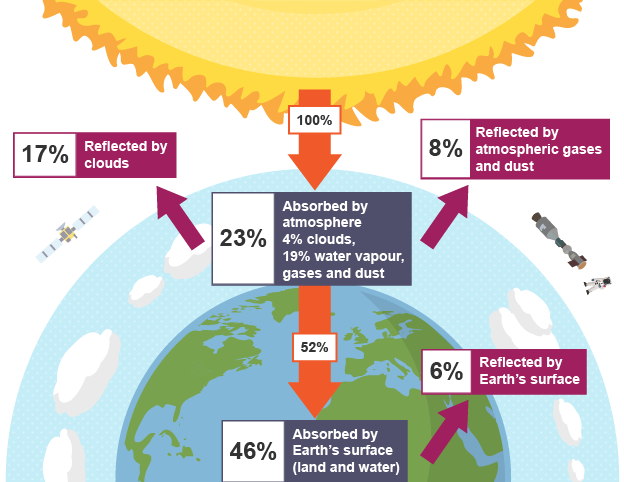
Global heat budget
The balance between incoming solar radiation and outgoing terrestrial radiation
What three conditions cause reflection in the global heat budget and what is the percentage?
Clouds: 20%
Dust and gas particles: 5%
Albedo effect: 5%
What two conditions cause absorption in the global heat budget and what is the percentage?
Clouds: 3%
Dust and gas particles: 17%
What percentage of the global heat budget is absorbed by the Earth’s surface?
50%
What are the two conditions in the atmosphere that contribute to the global heat budget?
Clouds and dust and gas particles
What is the condition on the Earth’s surface that contributes to the global heat budget?
The albedo effect
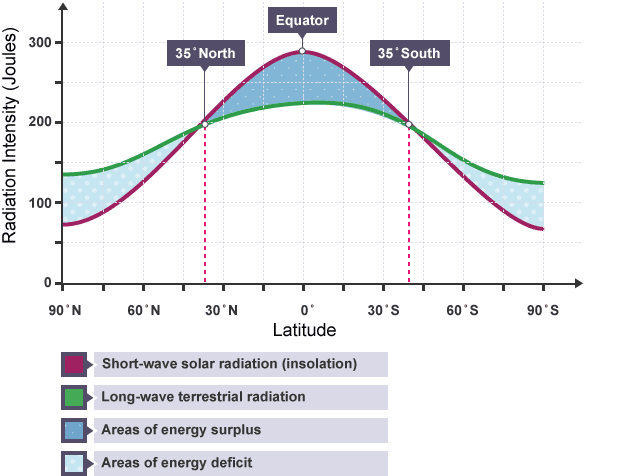
Differences in insolation
There is a net gain of energy in the tropics and a net loss of energy at the poles
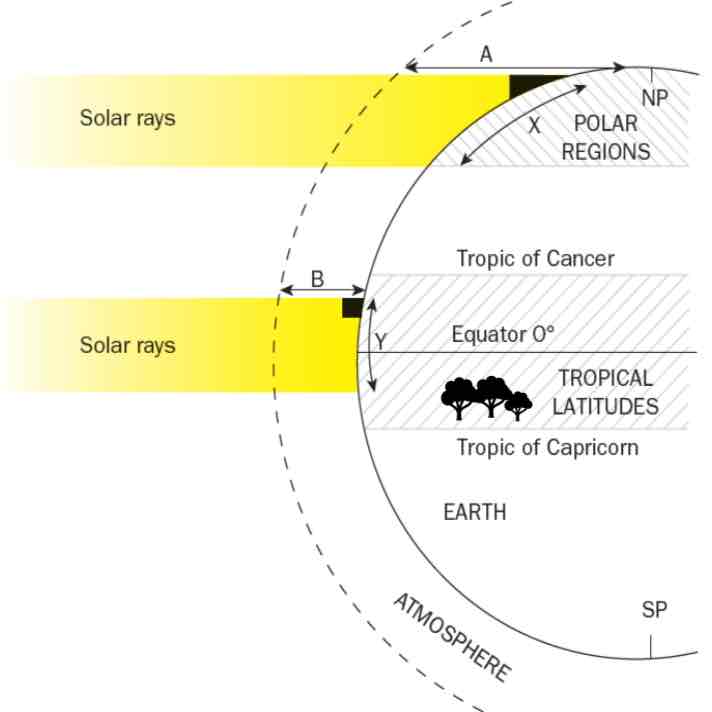
What four things contribute to a net gain of energy at the tropics and a net loss at the poles?
Albedo effect
Curvature of the Earth
Seasonal variation
Thickness of the atmosphere
Albedo effect
At polar regions, large amounts of snow and ice increase the albedo effect, more insolation is reflected at the poles than from the denser vegetation and oceans at the tropics
Curvature of the Earth
Heat energy is spread over a larger area at the poles, weakening the energy whereas at the tropics the sun’s energy is more concentrated, so the intensity of insolation is greater
Seasonal variation
The tilt of the Earth also changes at different times of the year, so insolation levels vary
Thickness of the atmosphere
The sun’s rays pass through less atmosphere at the equator, therefore less energy is lost through absorption and reflection
Seasonal variation in June
The northern hemisphere tilts towards the sun, meaning more solar energy is released, this creates summer conditions
What are the two ways that energy moves from the equators to the poles?
Atmospheric circulation and ocean currents
Atmospheric circulation
This is the transfer of energy from tropical latitudes where there is a net gain, to polar latitudes where there is a net loss
Air pressure
The weight of the gases in the atmosphere as they press down on the Earth’s surface
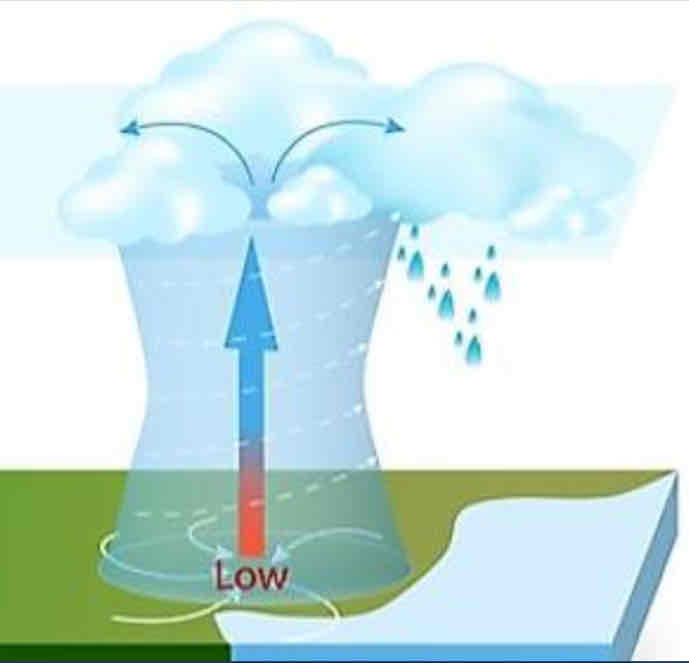
Low air pressure
When air is heated, it rises away from the surface which reduces the weight of air pressing down
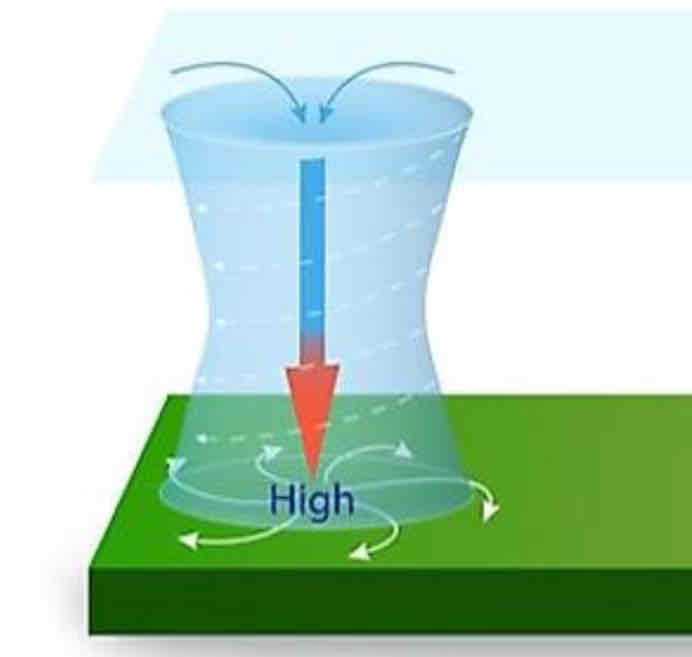
High air pressure
When air is cold, it sinks towards the surface which increases the weight of the air pressing down
Which areas do air pressures blow from?
Winds always blow from areas of high pressure to low pressure on the Earth’s surface
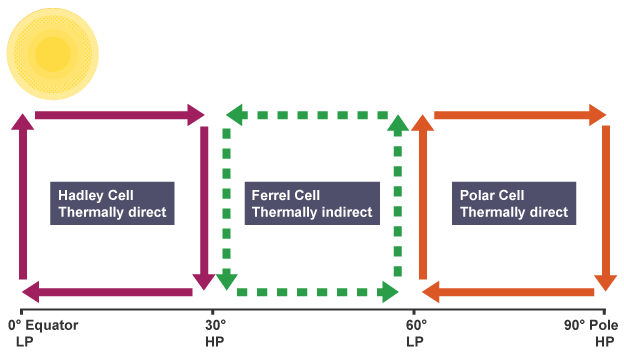
What are the three weather cells that control the movement of heat?
Polar cell
Ferrel cell
Hadley cell
Characteristics of the hadley cell
Heat from the sun is concentrated at the equator
Warm air rises at the equator due to intense heating from the sun, creating low pressure
As the warm air rises, it cools and sinks over the tropics, creating high pressure
Characteristics of the ferrel cell
Warm air from the hadley cell feeds into the ferrel cell
This warmer air then feeds into the polar cell
This transfers heat from the equator to the poles
Characteristics of the polar cell
Cold air sinks at the poles, creating high pressure
Cold polar air is transferred from lower latitudes by surface winds
Contact with the Earth’s surface causes it to warm and rise
Formation of the ferrel cell
This cell forms as a result of temperature differences between the hadley and polar cells
What are the three parts of atmospheric circulation?
Part one: air pressure
Part two: weather cells
Part three: surface wind patterns
What are the seven latitudes included in the surface wind patterns?
North pole
Arctic circle
Tropic of Cancer
Equator
Tropic of Capricorn
Antarctic circle
South pole
What are the three surface wind patterns?
Polar easterlies
Westerlies
Trade winds
Polar easterlies
Winds that travel from the poles to 60 degrees north and south
Westerlies
Winds that travel from 30 degrees north and south
Trade winds
Winds that travel from 30 degrees north (northeast trade winds) and south (southeast trade winds) of the equator
Convergence
The point where different winds meet or descend on a low pressure zone
Divergence
The point where different winds move away from the high pressure zones
What are the three points of convergence?
Arctic circle
Equator
Antarctic circle
What are the four points of divergence?
North pole
Tropic of Cancer
Tropic of Capricorn
South pole
Rossby waves (jet streams)
Wave-like patterns found in the westerlies that form as a result of temperature and pressure differences that can assist in energy transfer
Landmass deflection
The shape and height of the land can disrupt winds
How do rossby waves assist in energy transfer?
As they loop southwards, cold air is transferred to lower latitudes, and as they loop northwards, warm air is transferred to higher latitudes
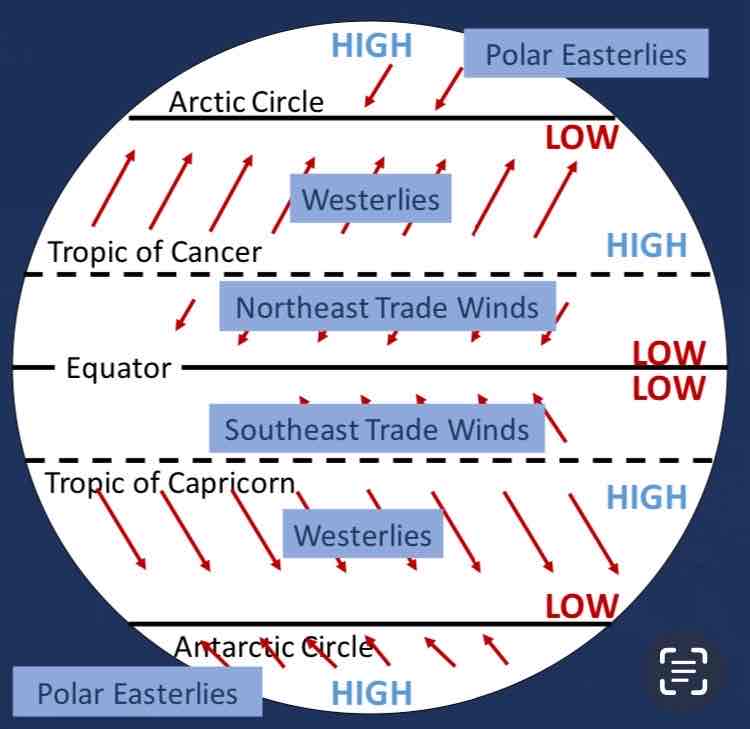
Surface wind patterns
Ocean currents
This is the permanent or continuous movement of oceanwater from one place to another
How do ocean currents transfer energy?
They can flow for thousands of km and can result in warm water being transferred to high latitudes (the poles) to cool water being transferred to low latitudes (the equator and tropics)
What is the purpose of ocean currents?
To warm up the poles and cool down the equator and tropics
What are the two types of ocean currents?
Cold currents and warm currents
Characteristics of cold currents
Flow from the poles towards the equator
Carry cold water (relative to the surrounding water)
They act to lower the temperatures of coastal areas
Characteristics of warm currents
Flow from the equator to the poles
Carry warm water (relative to the surrounding water)
They raise the temperatures of coastal areas making them warmer than would be expected for their latitude
Named example: cold currents
Labrador current
Named example: warm currents
North Atlantic drift
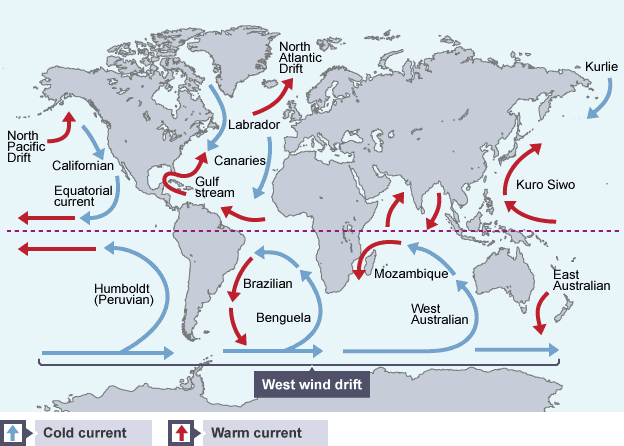
Pattern of ocean currents
What are the five things that affect the movement of ocean currents?
Prevailing winds
Coriolis effect
Water density
Gyres
Thermohaline circulation
Prevailing winds
Ocean currents are greatly influenced by the prevailing winds, energy is transferred by friction
Coriolis effect
This deflects currents to the right in northern latitudes and to the left in southern latitudes
Water density
Cold water is denser than warm water, so the cold water sinks away from the poles towards warmer regions
Gyres
The currents are obstructed by continental land masses, forming gyres as the currents loop
Thermohaline circulation
Colder water and that with a higher salt content is much denser than warmer waters with a lower salt content
Case study: ocean currents
The North Atlantic
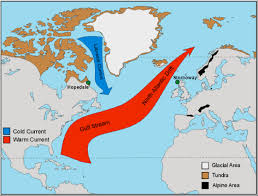
What are the six currents in the North Atlantic?
North Equatorial Current
Warm current- Gulf Stream
North Atlantic Drift
Warm current- North Atlantic Drift
Cold current- Labrador Current
Cold current- Canaries Current
Inter-tropical convergence zone
This is where the tropical continental and tropical maritime airmasses converge, bringing rising air from the tropics to the equator which results in low pressure
What kind of weather does low pressure bring?
Cloudy and windy weather with possible rain and/or storms
What kind of weather does high pressure bring?
Light winds and settled weather
Air mass
This is a large volume of rising air with the same humidity and temperature, bringing clouds, frequent thunderstorms, and heavy rainfall due to the low pressure
Air mass: polar and tropical
Polar refers to polar latitudes and tropical refers to tropical latitudes
Air mass: continental and maritime
Continental refers to air from across land and maritime refers to air from across the sea
What are the two air masses that influence the weather in Africa?
Tropical continental and tropical maritime
What kind of weather does tropical continental bring?
Brings extremely warm temperatures, dry stable air with no clouds or rainfall from the Sahara desert
What kind of weather does tropical maritime bring?
Brings humid, unstable air causing rainfall and thunderstorms from the Gulf of Guinea
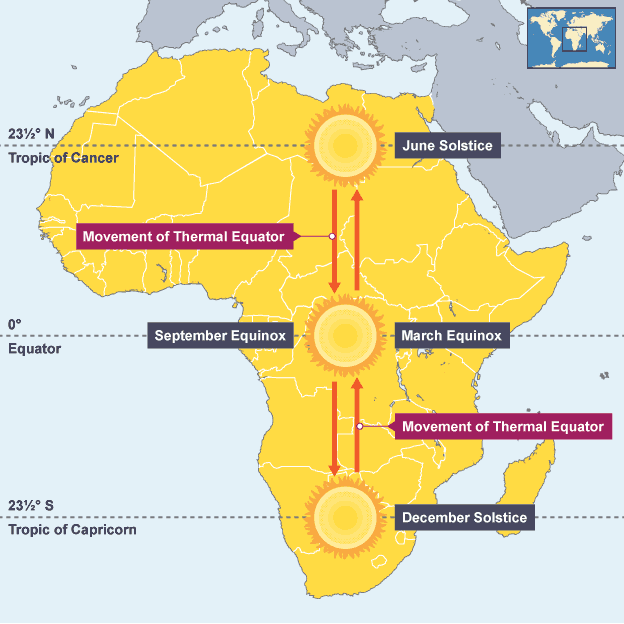
Migrating ITCZ
As the Earth’s tilt changes throughout the year so does the thermal equator along Africa
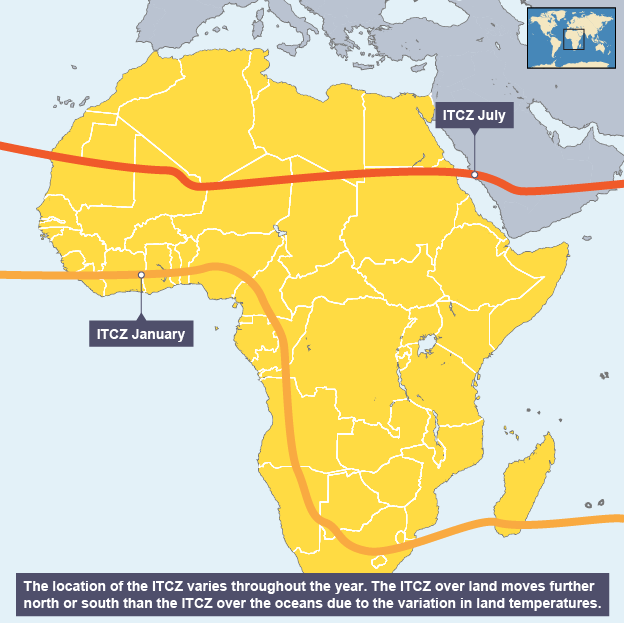
Migrating ITCZ in June
In July, the sun is directly over the Tropic of Cancer, causing the ITCZ to migrate northwards, which brings the wet season from the tropical maritime air mass
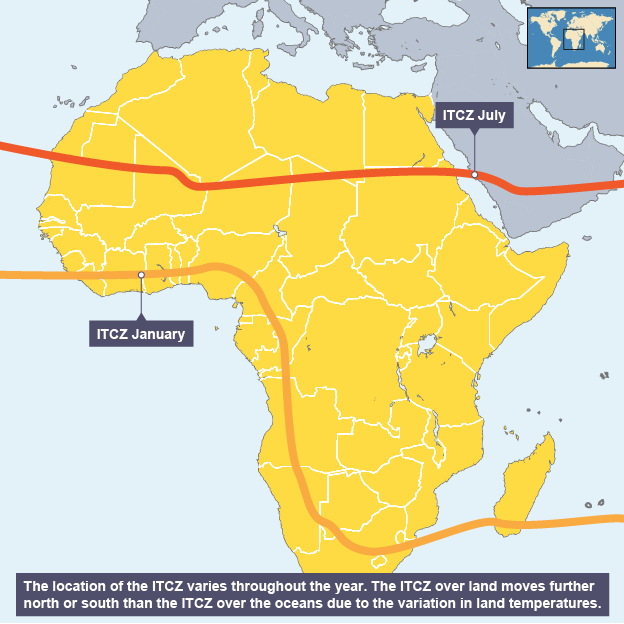
Migrating ITCZ in January
In January, the sun is directly over the Tropic of Capricorn, causing the ITCZ to migrate southwards, which brings the dry season from the tropical continental air mass
Climate graphs
This displays the levels of precipitation and temperature in a country during the dry and wet seasons